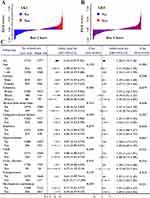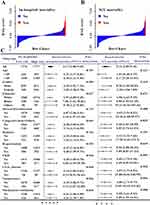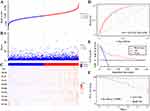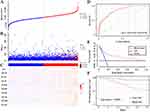Back to Journals » International Journal of Chronic Obstructive Pulmonary Disease » Volume 19
Prognostic Value of Leukocyte-Based Risk Model for Acute Kidney Injury Prediction in Critically Ill Acute Exacerbation of Chronic Obstructive Pulmonary Disease Patients
Received 2 November 2023
Accepted for publication 21 February 2024
Published 4 March 2024 Volume 2024:19 Pages 619—632
DOI https://doi.org/10.2147/COPD.S444888
Checked for plagiarism Yes
Review by Single anonymous peer review
Peer reviewer comments 4
Editor who approved publication: Dr Richard Russell
Min Cai,1,* Yue Deng,2,* Tianyang Hu3
1Department of Nephropathy and Rheumatism, Yongchuan Hospital of Chongqing Medical University (The Fifth Clinical College of Chongqing Medical University), Chongqing, People’s Republic of China; 2Department of Respiratory and Critical Care Medicine, The Fifth People’s Hospital of Chongqing, Chongqing, People’s Republic of China; 3Precision Medicine Center, The Second Affiliated Hospital of Chongqing Medical University, Chongqing, People’s Republic of China
*These authors contributed equally to this work
Correspondence: Tianyang Hu, Email [email protected]
Purpose: Acute kidney injury (AKI) is a common complication of acute exacerbation of chronic obstructive pulmonary disease (AECOPD), and inflammation is the potential link between AKI and AECOPD. However, little is known about the incidence and risk stratification of AKI in critically ill AECOPD patients. In this study, we aimed to establish risk model based on white blood cell (WBC)-related indicators to predict AKI in critically ill AECOPD patients.
Material and Methods: For the training cohort, data were taken from the Medical Information Mart for eICU Collaborative Research Database (eICU-CRD) database, and for the validation cohort, data were taken from the Medical Information Mart for Intensive Care-IV (MIMIC-IV) database. The study employed logistic regression analysis to identify the major predictors of WBC-related biomarkers on AKI prediction. Subsequently, a risk model was developed by multivariate logistic regression, utilizing the identified significant indicators.
Results: Finally, 3551 patients were enrolled in training cohort, 926 patients were enrolled in validation cohort. AKI occurred in 1206 (33.4%) patients in training cohort and 521 (56.3%) patients in validation cohort. According to the multivariate logistic regression analysis, four WBC-related indicators were finally included in the novel risk model, and the risk model had a relatively good accuracy for AKI in the training set (C-index, 0.764, 95% CI 0.749– 0.780) as well as in the validation set (C-index, 0.738, 95% CI: 0.706– 0.770). Even after accounting for other models, the critically ill AECOPD patients in the high-risk group (risk score > 3.44) still showed an increased risk of AKI (odds ratio: 4.74, 95% CI: 4.07– 5.54) compared to those in low-risk group (risk score ≤ 3.44). Moreover, the risk model showed outstanding calibration capability as well as therapeutic usefulness in both groups for AKI and ICU mortality and in-hospital mortality of critical ill AECOPD patients.
Conclusion: The novel risk model showed good AKI prediction performance. This risk model has certain reference value for the risk stratification of AECOPD complicated with AKI in clinically.
Keywords: risk model, acute kidney injury, prediction, white blood cell, acute exacerbation of chronic obstructive pulmonary disease
Introduction
A prevalent chronic inflammatory illness of the airways, chronic obstructive pulmonary disease (COPD) is defined by ongoing respiratory symptoms and reduced airflow.1 COPD is a common disease with high global morbidity and mortality and poses a major health and economic burden in the worldwide, which has become a significant public health issue. COPD was the fifth leading cause of death in 2002 and will rank third by 2030.2 Acute exacerbations of COPD (AECOPD) are episodes of worsening symptoms and patients who have frequent exacerbations have a lower quality of life, a faster deterioration in lung function, and are at a higher risk of myocardial infarctions, cerebrovascular events, and mortality.3
Patients may eventually need to be admitted to the intensive care unit (ICU) and undergo invasive mechanical ventilation (IMV) due to acute respiratory failure during an AECOPD.4 Acute kidney injury (AKI) is a common complication in patients admitted to the ICU.5 Literature reported 30–60% of critically ill patients developed AKI and AKI is associated with increased morbidity and mortality.6 Moreover, AKI is recognized as also a severe complication of AECOPD, AECOPD patients with AKI showed higher mortality compared to those without AKI.7 Hence, it is important to seek risk model or predictors of AKI in critically ill AECOPD patients, especially for biomarkers which can be easily obtained upon admission.
AECOPD and AKI share similar pathobiology in the development and progression, such as systemic inflammation. AECOPD is linked to increased systemic and airway inflammation.8 It is widely acknowledged that inflammation plays a significant role in the development of AKI.9 White blood cells (WBCs)-related indicators are easily obtained to predict AKI which has been used in different diseased setting.10,11 However, whether WBC-based risk model could predict AKI and clinical outcomes in critically ill AECOPD patients has not been explored. The present study aimed to demonstrate the incidence of AKI and construct a risk model-based on WBC indicators for AKI prediction in critically ill AECOPD patients.
Material and Methods
Data Source
An observational study was conducted using data from the eICU Collaborative Research Database (eICU-CRD)12 and the Medical Information Mart for Intensive Care IV (MIMIC-IV).13 The MIMIC-IV cohort was obtained from a relational database that had comprehensive information on more than 250,000 patients admitted to the Beth Israel Deaconess Medical Center in Boston, Massachusetts, in the United States, between 2008 and 2019. The multi-center telehealth database known as the eICU-CRD has information on over 200,000 admissions to 335 ICUs at 208 hospitals across the United States between 2014 and 2015. The study was carried out in accordance with the Helsinki Declaration. The establishment of the database was approved by the Massachusetts Institute of Technology (Cambridge, MA) and Beth Israel Deaconess Medical Center (BIDMC, Boston, MA) (No. 27653720), and consent was obtained for the original data collection. As this study was an analysis of the public databases, the Institutional Review Board of the Massachusetts Institute of Technology (MIT) at the granted a waiver of informed consent and approved the sharing of the research resource.
Study Population and AKI Definition
The International Classification of Diseases (ICD) code served as the foundation for the definition of AECOPD. The exclusion criteria were as followings: 1) less than 18-year-old; 2) lacking WBC-related signs on the first day of ICU admission; 3) patients with hospital stay less than 48-hours; 4) patients who had previously been admitted more than once. Based on serum creatinine in the first 48 hours of their ICU hospitalization, AKI and AKI severity were diagnosed using KDIGO-Scr criteria.14 The training cohort was made up of data from the eICU-CRD database, and the validation cohort was made up of data from the MIMIC-IV database. The comprehensive flowchart was displayed in Figure 1.
 |
Figure 1 The flow chart of this study. |
Clinic Variables and Outcomes
Demographics, vital signs, laboratory results, scoring systems, complications, comorbidities, and drug use were among the characteristics that were taken out. All information was gathered within 24 hours after ICU admission. The detailed variables are displayed in Table 1. The primary outcome was AKI. The secondary outcomes included AKI severity, usage of vasopressor, usage of mechanical ventilation, acute heart failure, acute respiratory failure, sepsis, length of ICU stay, length of hospital stay, in-hospital mortality and ICU mortality. SII was calculated as follows: platelets × neutrophils/lymphocytes.
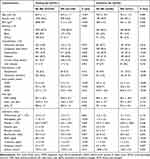 |
Table 1 Comparisons of Characteristics Between No AKI Group and AKI Group |
Statistical Analysis
For all of the analysis, the R (version 4.1.0) program was employed. In order to compare the two groups for continuous variables that were expressed as the mean [standard deviation (SD)], an independent sample t-test was performed. The categorical variables were quantified (expressed as a percentage), and the two groups were contrasted using the χ2 test. P 0.05 was used to indicate a statistically significant difference on either side.
Univariate and multivariate logistic regression analyses were used to select the WBC-markers significantly associated with AKI, and the novel AKI prediction risk model was then developed based on the coefficients of these factors in the multivariate logistic regression analysis was developed. The receiver operator characteristic curve (ROC) was used to guarantee the optimal cutoff value for the novel risk model. The creation of the high-risk group and low-risk group was based on the optimal cutoff value. Using decision curve analysis (DCA), the risk model’s clinical applicability was evaluated. To assess the risk model’s ability to forecast various clinical outcomes, multivariate logistic and COX regressions were also run. Subgroup analysis was represented by the forest plot. Waterfall plots were used to show the relationship between risk scores and clinical outcomes.15
Results
Baseline Demographic and Clinical Characteristics
The baseline characteristics of between the AKI group and no-AKI groups are listed in Table 1. Finally, 3551 patients were enrolled in training cohort, 926 patients were enrolled in validation cohort. AKI occurred in 1206 (33.4%) patients in training cohort, and 521 (56.3%) patients in validation cohort. In the training set, compared to those in non-AKI group, patients in AKI group were older, had higher BMI, higher proportion of congestive heart failure, hypertension, chronic kidney disease, mechanical ventilation, had higher SOFA score, OASIS score, APSIII score, higher bilirubin, BUN, creatinine, potassium and sodium, lower hemoglobin and albumin (all P < 0.05, Table 1). In the validation set, compared to those in non-AKI group, patients in AKI group had higher BMI, higher proportion of myocardial infarction, congestive heart failure, hypertension, chronic kidney disease, vasopressors and mechanical ventilation usage, higher SOFA score, OASIS score, APSIII score, higher BUN creatinine and lower hemoglobin, albumin and MAP (all P < 0.05, Table 1).
Risk Model Was Constructed Based on WBC-Related Indicators
According to the multivariate logistic regression analysis, four WBC-related indicators were finally included in the novel risk model, and the risk model was constructed based on the four WBC-related indicators, WBR, WHR, NLR and SII. Risk score: 0.067*WNR+0.441*Lg(WBR)+0.093*WHR+0.734*Lg(SII) (Table 2). The risk model’s C-index results for the prediction of AKI in critically ill patients demonstrated a reasonably excellent model discriminative power. C-index values for the training set were (0.764, 95% CI: 0.749–0.780) and for the validation set were (0.738, 95% CI: 0.706–0.770).
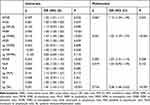 |
Table 2 Logistic Regression Analysis of WBC-Related Indicators for AKI in Training Set |
The Performance of the Novel Risk Model for AKI Prediction
We started by examining the relationships between risk score, severity score, and clinical outcomes. The novel risk model is closely linked to clinical outcomes, severity score, and WBC-related indicators both in the training set and in validation set, as seen in Figure 2A and B. The optimal cut-off value of the WBC-related indicators-based risk model was also determined using ROC analysis, and the low-risk (≤3.44) and high-risk (>3.44) groups were then split in accordance with this value. According to Table 3, patients in the high-risk group had a higher percentage of AKI, AKI severity, vasopressor use, mechanical ventilation use, acute respiratory failure, acute heart failure, sepsis, length of ICU stay, length of hospital stay, in-hospital mortality, and ICU mortality than those in the low-risk group both in the training set and in the validation set (all P < 0.05, Table 3, Supplemental Table 1).
 |
Table 3 Clinical Outcomes Analysis of High and Low Risk Groups for Patients in Training Set |
Additionally, a waterfall plot was used to evaluate the connection between the risk score and the likelihood of AKI. Figure 3A illustrates that the proportion of AKI increases with the risk score. Patients in high risk had a higher risk of AKI than those in the low-risk group in all subgroups in the training set according to the pre-specified subgroup analysis (Figure 3C), the results in the validation set showed similar to the training set (Supplemental Figure 1A). Even after accounting for other models, the critically sick AECOPD patients in the high-risk group still showed an increased risk of AKI (OR: 4.74, 95% CI: 4.07–5.54) (Table 4).
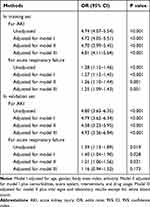 |
Table 4 Univariate and Multivariate Logistic Regression Analysis for Clinical Outcomes |
The Performance of the Novel Risk Model on Other Clinical Outcomes
The performance of the risk model is next evaluated for clinical outcomes other than AKI prediction, such as acute respiratory failure, ICU mortality and in-hospital mortality. When adjusted for various models in both the training set and the validation set, univariate and multivariate logistic regression analysis of the critically ill AECOPD patients showed that they were more likely to experience acute respiratory failure (Table 4), ICU mortality, and in-hospital mortality (Table 5). This was especially true for patients who were classified as high-risk by the WBC-related indicators risk model. Additionally, a waterfall plot analysis showed that there was a direct correlation between risk score and the proportion of cases of acute respiratory failure (Figures 3B), ICU mortality (Figure 4A), and in-hospital mortality (Figure 4B) both in the training set and validation set (Supplemental Figure 1B–D). Furthermore, in almost all subgroups, patients in the high-risk group were more likely than those in the low-risk group to experience acute respiratory failure (Figure 3C), ICU mortality, and in-hospital death.
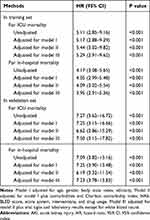 |
Table 5 Univariate and Multivariate COX Regression Analysis for Clinical Outcomes |
The risk score and ICU mortality of patients in the training set were correlated, as shown in Figure 5. The likelihood of dying in an ICU increases with higher risk score (Figure 5A and B). According to the heat-map (Figure 5C), patients in the high-risk category had higher values for WBC-related variables. Figure 5D shows that the risk score’s AUC for ICU mortality was 0.822 (95% CI: 0.786–0.858). The risk model was clinically beneficial in predicting ICU mortality, according to decision curve analysis (DCA) (Figure 5E). Additionally, the Kaplan–Meier curve analysis showed that the prognosis for the high-risk group was poorer than that of the low-risk group (Figure 5F). Consistent with predicting ICU mortality, this risk model also shows good predictive value for in-hospital mortality. Risk score raises the likelihood of dying in a hospital setting (Figure 6A and B). According to the heat-map (Figure 6C), patients in the high-risk category showed higher values for WBC-related factors. The risk score’s AUC for in-hospital mortality was 0.815 (95% CI: 0.794–0.835), as shown in Figure 6D. Decision curve analysis (DCA) revealed that the risk model was clinically useful in predicting in-hospital mortality (Figure 6E). Additionally, the prognosis for the high-risk group was worse than that for the low-risk group, according to the Kaplan–Meier curve analysis both in the training set and in the validation set (Figure 6F, Supplemental Figure 2).
Discussion
In the present study, we for the first time explored the incidence of AKI in critically ill AECOPD patients and constructed a novel risk model to AKI prediction. The main findings of this retrospective study demonstrated that AKI is a common complication in critically ill AECOPD patients, WBR, WHR, NLR and SII were found to be significant predictors of AKI, and WBC-related indicators-based risk model was established. The novel risk model including WBR, WHR, NLR and SII exhibited good predictive performance of AKI and other clinical outcomes including acute respiratory failure, ICU mortality, and in-hospital mortality.
Recent studies have found that AKI is a common complication of AECOPD patients which neglected by previous researchers. Barakat et al showed that the incidence of AKI in patients with COPD was 128/100,000 person-years, and the prevalence of AKI in patients with AECOPD was 1.9%.16 Hirayama et al reported that the incidence of AKI was 7.0% in AECOPD patients.17 Chen et al indicated that hospital-acquired AKI was 7.9% in AECOPD patient.18 Another study reported a higher AKI occurrence in AECOPD patients, Wan et al illustrated that 1768 patients admitted to Nanjing First Hospital with a principal diagnosis of AECOPD. Of these, 377 (21%) patients had AKI.19 Furthermore, Cao et al investigated the community-acquired AKI (CA-AKI) and hospital-acquired AKI (HA-AKI) in patients with AECOPD, and found that prevalence of CA-AKI was 15.8% and that of HA-AKI was 5.5%, giving an overall AKI prevalence of 21.3%.7 In the present study, we found 34.0% AKI in critically ill AECOPD patients in eICD-CRD database, and 56.3% AKI in critically ill AECOPD patients in MIMIC-IV. The difference of the incidence of AKI in these ICU databases might partly because of the severity of disease (MIMIC database was a single-center database from the Beth Israel Deaconess Medical Center, while the eICU database was a multi-center database from different levels of hospitals across the US).
AECOPD patients complicated with AKI exhibited worse prognosis than those non-AKI patients. Previous studies reported that AECOPD patients complicated with AKI were more likely to require non-invasive mechanical ventilation, had a longer duration of mechanical ventilation and duration of hospital stay, higher in-hospital mortality and higher all-cause readmission than those without AKI.16–19 Hence, it is important to seek biomarkers or risk model for early detection, early diagnosis, and early intervention of the disease can significantly improve prognosis and reduce patient mortality. Chen et al evaluated whether serum cystatin C on admission could predict AKI in patients with AECOPD and the results demonstrated that serum cystatin C has the potential for use to predict the risk of HA-AKI in patients with AECOPD.18 Another study also explored the potential biomarkers predict the AKI in AECOPD patients and concluded that hypoxia and inflammation might be risk factors for renal injury in patients with AECOPD, serum cystatin C and beta-2 (β2) microglobulin (β2-MG) could be sensitive indicators for the early detection of renal injury.20 Wei et al found that interleukin-10 (IL-10) and neutrophil gelatinase-associated lipocalin (NGAL) have a better diagnostic effect in AECOPD with AKI patients.21 However, biomarkers or risk models to predict AKI in AECOPD patients in the setting of ICU have not been explored.
The possible link between AECOPD and AKI was inflammation. AECOPD might result in a marked rise in endotoxin levels in the blood. An elevated level of endotoxin can stimulate the production of inflammatory factors, lead to blood vessel content to decrease, blood pressure to drop, renal perfusion to decrease, and vasodilation, vascular permeability, and serum protein exudation to increase, all of which directly impair kidney function. Large amounts of cytokines and inflammatory mediators can be released during an acute exacerbation. Numerous studies have revealed that people with COPD emit a range of inflammatory factors, including IL-6 and tumor necrosis factor (TNF)-α. Additionally, the levels of inflammatory factors considerably increase as the severity of COPD increases. Elevated TNF-α and IL-6 levels have been linked to renal injury development and progression, as demonstrated by animal and clinical investigations, which ultimately resulted in AKI.22,23 WBC is an easy-obtained indicator, which reflected the systemic inflammatory condition. Hence, this study aimed to develop a novel risk model based on the WBC-related indicators for AKI and prognosis of critical ill AECOPD patients.
In the present study, multivariate logistic regression analysis identified that WBR, WHR, NLR and SII were independent prognosis for AKI prediction, a novel AKI prediction model was then established. Previous research has described a prognosis prediction risk model based on WBC-related markers. According to a recent study by Gao et al, preoperative WHR, WMR, and PLR are related to the prognosis of bladder cancer. Based on these data, a risk model was developed that demonstrated good prognosis predicting performance.10 Another study looked into the use of WBC-related indicators to predict AKI in patients with critically sick ischemic strokes, the findings showed that a risk model based on WLR, WBR, WHR, and NLR performed well in predicting AKI in these patients.11 Consistent with previous research results, our results manifested that the novel risk model, which integrated WBC-related indicators WBR, WHR, NLR and SII, exhibited excellent predictive performance of AKI as well as acute respiratory failure, ICU mortality, and in-hospital mortality.
Several limitations of this study should be addressed. Firstly, this study was a retrospective study based on two largely public database, and the results should be verified by external validation; therefore, large-scale multicenter prospective cohort studies are necessary to strengthen the results. Second, data such as COPD severity stage were not available in this study, and moreover, the diagnosis of AECOPD based on the ICD code in this retrospective study. Thirdly, only WBC-related indicators within 24 hours after ICU admission were collected, dynamic changes of WBC-related indicators are needed. Moreover, due to the possibility of incorrect urine volume data from the use of diuretics, the urine standard was not employed in the diagnosis of AKI. AKI’s overall incidence rate might decline as a result.
Conclusion
The incidence of AKI is common in critically ill AECOPD patients. A novel risk model based on WBC-related indicators which contained WBR, WHR, NLR and SII was established, and this risk model exhibited good clinical outcomes predictive performance.
Data Sharing Statement
The datasets used are available from the corresponding author on reasonable request.
Ethics Approval and Consent to Participate
As this study was an analysis of the public databases, approval of the Institutional Review Board (IRB) was completely exempted. And the ethical approval statement and the need for informed consent were waived for this manuscript.
Consent for Publication
All authors consent for publication.
Author Contributions
All authors made a significant contribution to the work reported, whether that is in the conception, study design, execution, acquisition of data, analysis and interpretation, or in all these areas; took part in drafting, revising or critically reviewing the article; gave final approval of the version to be published; have agreed on the journal to which the article has been submitted; and agree to be accountable for all aspects of the work.
Funding
There is no funding to report.
Disclosure
Min Cai and Yue Deng are co-first authors for this study. The authors declare that they have no conflicts of interest in this work.
References
1. Vogelmeier CF, Criner GJ, Martinez FJ, et al. Global strategy for the diagnosis, management, and prevention of chronic obstructive lung disease 2017 report: GOLD executive summary. Eur Respir J. 2017;49(3):1700214. doi:10.1183/13993003.00214-2017
2. Halpin DMG, Criner GJ, Papi A, et al. Global initiative for the diagnosis, management, and prevention of chronic obstructive lung disease. The 2020 GOLD science committee report on COVID-19 and chronic obstructive pulmonary disease. Am J Respir Crit Care Med. 2021;203(1):24–36. doi:10.1164/rccm.202009-3533SO
3. Riley CM, Sciurba FC. Diagnosis and outpatient management of chronic obstructive pulmonary disease: a review. JAMA. 2019;321(8):786–797. doi:10.1001/jama.2019.0131
4. Crisafulli E, Barbeta E, Ielpo A, Torres A. Management of severe acute exacerbations of COPD: an updated narrative review. Multidiscip Respir Med. 2018;13:36. doi:10.1186/s40248-018-0149-0
5. Pickkers P, Darmon M, Hoste E, et al. Acute kidney injury in the critically ill: an updated review on pathophysiology and management. Intensive Care Med. 2021;47(8):835–850. doi:10.1007/s00134-021-06454-7
6. Hoste EAJ, Kellum JA, Selby NM, et al. Global epidemiology and outcomes of acute kidney injury. Nat Rev Nephrol. 2018;14(10):607–625. doi:10.1038/s41581-018-0052-0
7. Cao CC, Chen DW, Li J, et al. Community-acquired versus hospital-acquired acute kidney injury in patients with acute exacerbation of COPD requiring hospitalization in China. Int J Chron Obstr Pulmon Dis. 2018;13:2183–2190. doi:10.2147/COPD.S164648
8. Groenewegen KH, Postma DS, Hop WC, Wielders PL, Schlösser NJ, Wouters EF; COSMIC Study Group. Increased systemic inflammation is a risk factor for COPD exacerbations. Chest. 2008;133(2):350–357. doi:10.1378/chest.07-1342
9. Sato Y, Yanagita M. Immune cells and inflammation in AKI to CKD progression. Am J Physiol Renal Physiol. 2018;315(6):F1501–F1512. doi:10.1152/ajprenal.00195.2018
10. Gao M, Yang Q, Xu H, Chen Z, Wang X, Guo H. Preoperative white blood cell-related indicators can predict the prognosis of patients with transurethral resection of bladder cancer. J Inflamm Res. 2022;15:4139–4147. doi:10.2147/JIR.S373922
11. Liu S, Li M, Yang Y, Chen Y, Wang W, Zheng X. A novel risk model based on white blood cell-related biomarkers for acute kidney injury prediction in patients with ischemic stroke admitted to the intensive care unit. Front Med Lausanne. 2022;9:1043396. doi:10.3389/fmed.2022.1043396
12. Pollard TJ, Johnson AEW, Raffa JD, Celi LA, Mark RG, Badawi O. The eICU collaborative research database, a freely available multi-center database for critical care research. Sci Data. 2018;5:180178. doi:10.1038/sdata.2018.178
13. Liu T, Zhao Q, Du B. Effects of high-flow oxygen therapy on patients with hypoxemia after extubation and predictors of reintubation: a retrospective study based on the MIMIC-IV database. BMC Pulm Med. 2021;21(1):160. doi:10.1186/s12890-021-01526-2
14. Fliser D, Laville M, Covic A, et al; Ad-hoc working group of ERBP. A European Renal Best Practice (ERBP) position statement on the Kidney Disease Improving Global Outcomes (KDIGO) clinical practice guidelines on acute kidney injury: part 1: definitions, conservative management and contrast-induced nephropathy. Nephrol Dial Transplant. 2012;27(12):4263–4272. doi:10.1093/ndt/gfs375
15. Qamar A, Giugliano RP, Keech AC, et al. Interindividual variation in low-density lipoprotein cholesterol level reduction with evolocumab: an analysis of Fourier trial data. JAMA Cardiol. 2019;4(1):59–63. doi:10.1001/jamacardio.2018.4178
16. Barakat MF, McDonald HI, Collier TJ, et al. Acute kidney injury in stable COPD and at exacerbation. Int J Chron Obstruct Pulmon Dis. 2015;10:2067–2077. doi:10.2147/COPD.S88759
17. Hirayama A, Goto T, Hasegawa K. Association of acute kidney injury with readmissions after hospitalization for acute exacerbation of chronic obstructive pulmonary disease: a population-based study. BMC Nephrol. 2020;21(1):116. doi:10.1186/s12882-020-01780-2
18. Chen D, Cao C, Jiang L, et al. Serum cystatin C: a potential predictor for hospital-acquired acute kidney injury in patients with acute exacerbation of COPD. Chron Respir Dis. 2020;17:1479973120940677. doi:10.1177/1479973120940677
19. Wan X, Chen D, Tan Y, et al. Incidence, risk factors, and prognostic implications of acute kidney injury in patients with acute exacerbation of COPD. Int J Chron Obstruct Pulmon Dis. 2020;15:1085–1092. doi:10.2147/COPD.S238343
20. Zhang D. Correlation analysis of early renal injury in elderly patients with acute exacerbations of chronic obstructive pulmonary disease. Int J Chron Obstruct Pulmon Dis. 2022;17:2109–2115. doi:10.2147/COPD.S377847
21. Wei B, Tian T, Liu YG. IL-10 combined with NGAL has diagnostic value for AECOPD combined with AKI. Int J Chron Obstruct Pulmon Dis. 2020;15:637–644. doi:10.2147/COPD.S245541
22. Ghosh N, Choudhury P, Kaushik SR, et al. Metabolomic fingerprinting and systemic inflammatory profiling of asthma COPD overlap (ACO). Respir Res. 2020;21(1):126. doi:10.1186/s12931-020-01390-4
23. Singbartl K, Formeck CL, Kellum JA. Kidney-immune system crosstalk in AKI. Semin Nephrol. 2019;39(1):96–106. doi:10.1016/j.semnephrol.2018.10.007
 © 2024 The Author(s). This work is published and licensed by Dove Medical Press Limited. The full terms of this license are available at https://www.dovepress.com/terms.php and incorporate the Creative Commons Attribution - Non Commercial (unported, v3.0) License.
By accessing the work you hereby accept the Terms. Non-commercial uses of the work are permitted without any further permission from Dove Medical Press Limited, provided the work is properly attributed. For permission for commercial use of this work, please see paragraphs 4.2 and 5 of our Terms.
© 2024 The Author(s). This work is published and licensed by Dove Medical Press Limited. The full terms of this license are available at https://www.dovepress.com/terms.php and incorporate the Creative Commons Attribution - Non Commercial (unported, v3.0) License.
By accessing the work you hereby accept the Terms. Non-commercial uses of the work are permitted without any further permission from Dove Medical Press Limited, provided the work is properly attributed. For permission for commercial use of this work, please see paragraphs 4.2 and 5 of our Terms.


